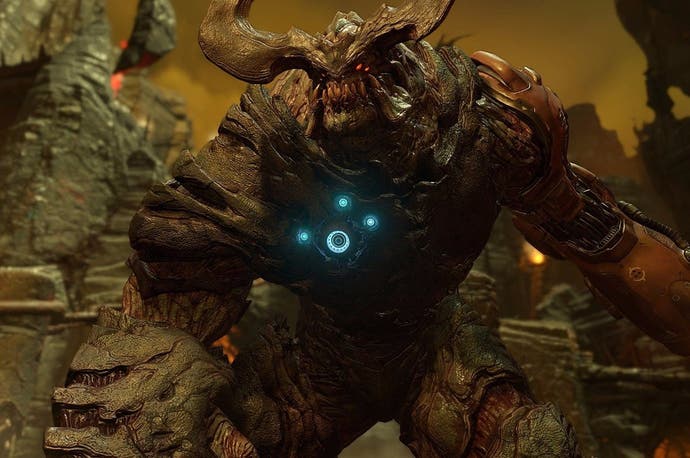Performance Analysis: Doom beta on PS4 and Xbox One
UPDATE: id Software confirms dynamic resolution scaling on both console versions.
UPDATE 20/4/16 18:51: id Software's Tiago Sousa got in contact to confirm that both versions of Doom actually utilise dynamic resolution scaling, rendering at up to 1080p. Sousa also reveals that the temporal anti-aliasing component uses an impressive 8x sampling and is tied in directly to the dynamic scaler, "so transitions are relatively hard to spot".
Original story: Bethesda's Doom reboot has seen several beta revisions released over the last few months, with patches and various tweaks added to the game as id Software refine the experience ahead of the title's May 13th release. Targeting 60fps for both campaign and multiplayer, Doom is an ambitious project, and a consistently high frame-rate is essential for this style of turbo-charged gameplay.
The multiplayer aspect of the game has drawn criticism about the use of loadouts and levelling up - a valid line of criticism bearing in mind the series' roots - though it's too early to tell exactly how much of an imbalance this will create. However, beyond the gameplay controversies, the technological experience holds up well across both PlayStation 4 and Xbox One, delivering a mostly solid experience at the desired 60fps refresh.
And this does seem to have been a genuine beta test - with id making changes and refining the tech across the various builds we've played, both open and closed. For example, an adaptive v-sync was present in the previous beta tests, resulting in noticeable screen-tear during the most intense scenes. However, with the final beta build we tested earlier this week, this is no longer the case, with the refined code maintaining v-sync at all times without too much of a hit to performance.
Indeed, frame-rates appear similar to the previous, closed beta on PS4, but without any tearing and wobble manifesting in more demanding scenes. Online stability is also much better on Xbox One, after issues we encountered during the last closed beta, where we could not progress beyond the matchmaking screen. This time, we had no issue getting into a match, and while matchmaking can be slow at first, once into a lobby we encountered no further delays.
Performance is improved all round then, and both consoles offer up a very similar experience across the run of play. At points where the engine is more heavily stressed, taxing alpha transparencies from weapons fire create mild stutter that quickly disappears as frame-rates snap back from 55fps to the target 60fps update. It's a mildly jarring experience, but thankfully, the engine doesn't falter for long, and gameplay mostly sticks to the performance target for extended periods. The worst we saw on Xbox One was a 50fps dip we could not recreate on PS4, but this was the exception rather than the rule.
Achieving this level of stability on Xbox One doesn't come for free - but it's a compromise we've seen before that doesn't have an unduly negative impact on gameplay. A 900p native resolution is deployed compared to a full HD framebuffer on PlayStation 4. Image quality isn't quite so pristine on Microsoft's console - however, the use of temporal anti-aliasing (TSSAA) along with the muted colour scheme ensures that there are no obvious upscale artefacts on screen. Edges appear smooth, with the combination of temporal supersampling and shader coverage providing a clean image that holds up very well against the PS4 version - which in itself looks rather soft too. It's rare we see such clean imagery outside of running on PC with extreme levels of supersampling, and that's great to see.
The maps present in the beta also give us a closer look at the new idTech 6 in action, and this throws up a few interesting enhancements over the visuals seen in the developer's last title, Rage. Dynamic lighting and shadows are more liberally deployed throughout the game, leading to extra visual flair during combat, while texture pop-in is less visible than before. It appears that there's less of a focus on one particular rendering ideology with this new engine. For example, mega-texturing still remains in some form in idTech 6, but thankfully this doesn't appear to limit the use of lighting and dynamic effects to the extent we saw in Rage. On top of that, performance doesn't suffer either with the increase in dynamic elements, as we saw in The Evil Within, based on idTech 5.
Of course, there are some issues still present from the inclusion of the virtual texturing technology. Texture mip-maps load in based on camera angle and proximity, so some asset pop between low and high quality artwork still occurs. And the baseline texture resolution is pretty low, with surfaces lacking intricate high frequency details found on many current-gen titles - one aspect of the game that disappoints. On the flipside, shadows are smooth and refined, while environment shadows lack the stair-step artefacts usually thrown up by real-time equivalents on consoles. There's definitely a balance of real-time and pre-computed elements going on here, and this works well from what we've seen of the game so far.
On the whole, the multiplayer portion of Doom is shaping up to be a solid performer on both consoles, with a consistent 60fps clearly within reach. Controls feel crisp and responsive, and frame-rate drops don't cripple gameplay when the engine is under load. In that respect Doom is on course to deliver exactly what is required from a competitive shooter; responsive controls, smooth motion, and fast-paced gameplay.
That said, from what we've seen so far, the single-player portion is a more visually accomplished exercise, with increased environment detail and more elaborate effects work. It's technically more demanding than the multiplayer portion, and hitting the same solid level of performance could be challenging. There's only a few short weeks until the game is released, so we shouldn't have to wait for too long until we find out just how far id has pushed this technology, and just how vice-like its grip on 60fps gameplay really is.


















